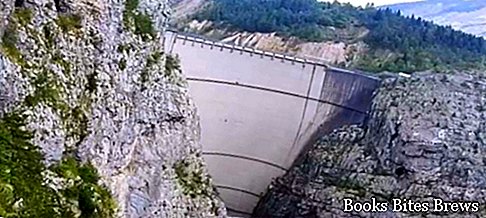What to see in Erto and Casso, an itinerary including the main places of interest, including the Vajont dam, visitor center and San Bartolomeo Church, as well as interesting naturalistic excursions.
Tourist information
In a natural setting of exceptional beauty, the small villages of Erto and Casso rise, which stand out for their simple architecture typical of the mountains.
Between the two inhabited areas there are rather marked linguistic differences, in fact in Erto there is spoken a dialect resulting from the Dolomite Ladin, while in Casso the Friulian Ladin is used, which is a typical dialect of Belluno.
The many paths available offer the possibility of excursions to discover old abandoned huts, meeting along the way particular rock conformations, such as the one on Mount Borgà.
At the end of the 1950s, the local economy was mainly based on traditional agriculture and small itinerant trade.
At the turn of the fifties and sixties, Sade started the project that envisaged using the Vajont valley as an artificial basin oriented towards the production of hydroelectric energy.
For this purpose, a 265m high double curvature dam was erected in the Colombèr gorge.
In 1960, when the filling of the first test reservoir began, there were two landslides, following which monitoring of the slope appeared unstable, which had an extension of about two hundred hectares.
A new test was carried out in 1962 and a subsequent one the following year but, despite the signs of an imminent landslide, the necessary measures were not implemented to secure the inhabited centers located downstream, due to inexperience and negligence.
In 1955, when the construction of the highest double-curvature dam in the world had just started on the territory of the Municipality of Erto and Casso, it would serve to block the Vajont stream to create the artificial basin, Erto and Casso together numbered 2,100 inhabitants.
On 9 October 1963 a wave of gigantic proportions, caused by the landslide of Mount Toc, destroyed many countries, causing over 2000 deaths, especially in Longarone and Castello Lavazzo, resulting in the evacuation of Erto and Casso, believed to be a high risk area, the whose inhabitants had to move to other inhabited centers.
Recommended readings- Venzone (Friuli Venezia Giulia): what to see
- Friuli Venezia Giulia: 1-day Sunday trips
- Arta Terme (Friuli Venezia Giulia): what to see
- Spilimbergo (Friuli Venezia Giulia): what to see
- Aquileia (Friuli Venezia Giulia): what to see
The theme relating to the Vajont disaster is widely treated in the Erto Visitor Center, which traces in detail all the individual phases, from the design of the dam to the final judgment of the process.
What see
At the Visitor Center information is available on the trails in the area, intended for nature excursions.
In Erto there is also one of the best known rock gyms, which attracts millions of enthusiasts every year.
As for the typical gastronomic specialties, polenta with game and frico should be remembered, besides other traditional dishes are those based on common herbs collected in the lawn.
Among the events, Erto and Casso retain ancient customs, including that of Good Friday, an event that consists of a suggestive representation of the passion and death of Christ, in which characters in Roman costumes participate.
Announced since the previous days through the drum roll, the Passion is preceded in the afternoon by a sacred procession, where the oldest in the country, while holding a pole topped by a wooden rooster, stands before a barefoot person, dressed in white and hooded, carrying the cross of Brustolon, supported in turn by two other people without shoes on their feet.
Among the monuments and places of interest is the parish church of San Bartolomeo, which houses a beautiful wooden crucifix from 1690 made by Andrea Brustolon, known as the Michelangelo of wood.
The Vajont dam is a disused dam built on the project of the engineer Carlo Semenza, in the period between 1957 and 1960, within the municipal area of Erto and Casso, sadly known for the disaster that occurred in 1963.




